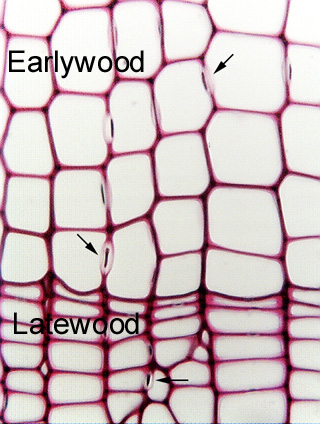Up
Primary xylem
Oak wood
Leaf vein
Vein ends
Bean seed
Pine tracheids, xs
Fern TE, xs
Fern, TE, mag
Annular walls
Annular, stretched
Annular, narrow
Scalariform walls
Scalar., narrow
CBP, pine
CBP, dicot
CBP, irregular
Contact faces
Pits, side view
CBP, pine, xs
CBP,angio, xs
CBP, fern, xs
Contact face, xs
Simple perf. plate 1
Simple perf. plate 2
Pitted perf. plate
Perf. plate & helix
Perf. plate, face
Perf. plate, mag
Perf. plate, section
Perf. plate rim
Perf. plate & wall
Scalariform Per plate
Primary xylem
Vessel sizes
Fern TE
Pine needle
VE precursor, ls
Protoxylem
9 Contact faces
VE precursor, xs
Precursor 2
Torn vessel
Torn vessel 2
| |
 Fig.
7.1-6. Transverse section of pine wood (Pinus).
All cells in this micrograph are tracheids.
You can not tell that from simply looking at this section, but rather by knowing
that it is a sample of pine, which has lacks both vessels and fibers. The three
arrows indicate circular bordered pits; any
cell with bordered pits will be a tracheary element, not a fiber. If
this were an unknown sample, you could search for perforations -- if these were
vessels, a perforation should be visible somewhere (although in transverse
section, it might be difficult to recognize). An
important clue that these are tracheids and not vessels is that they
are all so similar in diameter -- they are uniformly large in the earlywood and
uniformly smaller in the latewood. Vessels typically are present in several
sizes, and are virtually always associated with other cells that are smaller
than they. The uniformity here, along with the circular bordered pits, indicates
that these are tracheids. Fig.
7.1-6. Transverse section of pine wood (Pinus).
All cells in this micrograph are tracheids.
You can not tell that from simply looking at this section, but rather by knowing
that it is a sample of pine, which has lacks both vessels and fibers. The three
arrows indicate circular bordered pits; any
cell with bordered pits will be a tracheary element, not a fiber. If
this were an unknown sample, you could search for perforations -- if these were
vessels, a perforation should be visible somewhere (although in transverse
section, it might be difficult to recognize). An
important clue that these are tracheids and not vessels is that they
are all so similar in diameter -- they are uniformly large in the earlywood and
uniformly smaller in the latewood. Vessels typically are present in several
sizes, and are virtually always associated with other cells that are smaller
than they. The uniformity here, along with the circular bordered pits, indicates
that these are tracheids.
Could this be a mix of tracheids and fibers? After all, many of the cells
do not have circular bordered pits in this view. To be certain that there are no
fibers present, it would be necessary to examine many transverse sections and
check to make certain some cells completely lack circular bordered pits. Or
longitudinal sections could be checked -- that is much easier and faster. But
keep in mind that conifers like pines are called softwoods
because they lack
xylary fibers.
|
 Fig.
7.1-6. Transverse section of pine wood (Pinus).
All cells in this micrograph are tracheids.
You can not tell that from simply looking at this section, but rather by knowing
that it is a sample of pine, which has lacks both vessels and fibers. The three
arrows indicate circular bordered pits; any
cell with bordered pits will be a tracheary element, not a fiber. If
this were an unknown sample, you could search for perforations -- if these were
vessels, a perforation should be visible somewhere (although in transverse
section, it might be difficult to recognize). An
important clue that these are tracheids and not vessels is that they
are all so similar in diameter -- they are uniformly large in the earlywood and
uniformly smaller in the latewood. Vessels typically are present in several
sizes, and are virtually always associated with other cells that are smaller
than they. The uniformity here, along with the circular bordered pits, indicates
that these are tracheids.
Fig.
7.1-6. Transverse section of pine wood (Pinus).
All cells in this micrograph are tracheids.
You can not tell that from simply looking at this section, but rather by knowing
that it is a sample of pine, which has lacks both vessels and fibers. The three
arrows indicate circular bordered pits; any
cell with bordered pits will be a tracheary element, not a fiber. If
this were an unknown sample, you could search for perforations -- if these were
vessels, a perforation should be visible somewhere (although in transverse
section, it might be difficult to recognize). An
important clue that these are tracheids and not vessels is that they
are all so similar in diameter -- they are uniformly large in the earlywood and
uniformly smaller in the latewood. Vessels typically are present in several
sizes, and are virtually always associated with other cells that are smaller
than they. The uniformity here, along with the circular bordered pits, indicates
that these are tracheids.